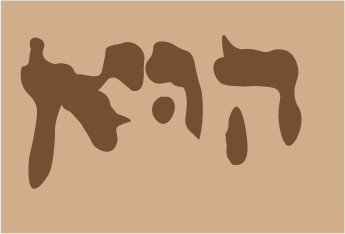In my spare time I am doing research for a video on a text-critical problem in Genesis 3:15. In the Vulgate, Genesis 3:15 says:
Genesis 3:15 (Vulgate) – 15 inimicitias ponam inter te et mulierem et semen tuum et semen illius ipsa conteret caput tuum et tu insidiaberis calcaneo eius
Genesis 3:15 (Vulgate) – 15 I will put hostility between you and the woman and between your seed and her seed. She herself will crush your head and you will lie in wait for her heel. (Translation mine)
This reading is quite different from the reading that is found in Masoretic manuscripts from the medieval period. These manuscripts form the starting point for modern translations of the Old Testament from Hebrew into English. In Firkovich B19a (i.e. Codex Leningradensis), Genesis 3:15 reads as follows:
וְאֵיבָ֣ה׀ אָשִׁ֗ית בֵּֽינְךָ֙ וּבֵ֣ין הָֽאִשָּׁ֔ה וּבֵ֥ין זַרְעֲךָ֖ וּבֵ֣ין זַרְעָ֑הּ ה֚וּא יְשׁוּפְךָ֣ רֹ֔אשׁ וְאַתָּ֖ה תְּשׁוּפֶ֥נּוּ עָקֵֽב׃
Genesis 3:15 – 15 And I will put hostility between you and between the woman, and between your seed and between her seed. He [or they] will crush you on the head and you will crush him [or them] on the heel. (Translation mine)
The most striking difference between these two readings is that in the Vulgate, the person who will crush the head of the serpent is a she (ipsa) while in Masoretic manuscripts the person who will crush the head of the serpent is a he (הוּא) or a they (referring back to the seed).
Like I mentioned earlier, I will be doing a video that deals with this issue in more detail from a text-critical perspective and will also likely do a blog post to accompany it. But at this point I would like to discuss an argument that is sometimes used to justify the reading that is found in the Vulgate.
It is sometimes said that the reading found in the Vulgate (ipsa) is supported by two Hebrew manuscripts: Kennicott 227 and Kennicott 239. The word Kennicott refers to a publication from the 18th century by Benjamin Kennicott (1718-1783) called Vetus Testamentum hebraicum cum variis lectionibus. This publication, which is still in use today, lists variants to the Hebrew text of the Old Testament based on 615 medieval Hebrew manuscripts and 52 print editions of the Hebrew text. The variants are recorded in the footnotes of the text.
On page 5 of volume one, which covers Genesis 3:15, the note says that the pronoun היא is found in two manuscripts: #227 and #239. Here is a picture of the entry:

Out of curiosity I decided to look for images of these manuscripts to see whether or not these manuscripts actually had the pronoun היא. After all, as Ernst Würthwein (The Text of the Old Testament 2nd ed., 40) notes, the individuals who consulted these manuscripts for Kennicott were not always competent.
In order to find these manuscripts I consulted Hebrew Manuscripts in the Vatican Library Catalogue (ed. Benjamin Richler; Vatican City: Biblioteca Apostolica Vaticano, 2008). This book includes detailed descriptions of the Hebrew manuscripts in the Vatican Library. Quite usefully, these descriptions provide the corresponding number in Kennicott for each manuscript at the end of the entry.
Kennicott 227 is listed as Vat. ebr. 9 in the Vatican Library. Vat. ebr. 9 is a Hebrew manuscript that was copied in Rome in 1287 CE. Kennicott 239 is listed as Vat. ebr. 447. Vat. ebr. 447 is a Hebrew manuscript that was copied in Spain in the 14th century. Both manuscripts can be viewed on the Vatican Library’s website (Vat. ebr. 9 – https://digi.vatlib.it/view/MSS_Vat.ebr.9; Vat. ebr. 447 – https://digi.vatlib.it/view/MSS_Vat.ebr.447). A useful list of digitized Hebrew manuscripts can be found on the website of the Bodleian Library (http://bav.bodleian.ox.ac.uk/digitized-items-hebrew-manuscripts).
After examining both of these manuscripts, it seems clear that the note in Kennicott is mistaken. Kennicott 227 and 239 do not have the pronoun היא; both have the pronoun הוא, just like Firkovich B19a. Here is a sketch I made of the pronoun that is used in Kennicott 227 (I do not own the rights to the original image of the manuscript but it can be verified using the link above):

It is easy to see how the person who consulted this manuscript could have mistaken the letter ו for the letter י. However, it is quite clear that the middle letter is ו. This can be seen for four reasons. First, the following word has both a ו and a י. This letter clearly matches up with the ו in the following word. Second, the ו in the word הוא has a dot to the left of it, indicating that this letter represents a long u sound. If it were a י, the dot would have been written below the ה. Third, third feminine singular pronouns are normally not written as היא in the Pentateuch. They are normally written as הוא (the third masculine singular personal pronoun) with the vowel that you would expect to see with היא. Finally, the pronoun היא doesn’t match up grammatically with the third masculine singular verb that follows.
Here is a sketch I did of the pronoun in Kennicott 239 (I do not own the rights to the original image of the manuscript but it can be verified using the link above):

In this case it is clear that the pronoun is הוּא.
Needless to say, this does not answer the question of why the Vulgate says that the person who would crush the head of the serpent is a she. But it clearly does show that Kennicott 227 and 239 should not be used to support the reading found in the Vulgate.
Mark Steven Francois (Ph.D., University of St. Michael’s College)